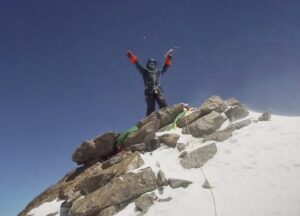Only four expeditions, 15 people in all, have climbed Masherbrum. Its West Face remains unclimbed. Its even bigger Northeast Face ranks as one of the most difficult big walls in the world and among the greatest unsolved problems in modern high-altitude climbing. The latest successes happened almost 40 years ago. Could this be the year that someone tries again?
Masherbrum = K1
Masherbrum is so impressive that 19th-century British geographers, viewing the Karakoram from distant Harmukh, thought it was the tallest in the whole range. They called it K1.

One of the early attempts. Photo: Galen Rowell/Baltoro Adventures
In fact, its 7,821m summit comprises an entire massif that includes such coveted peaks as Chogolisa and K6. American aces George Bell and Willi Unsoeld (and Nick Clinch and Pakistani Jawed Akhter Khan shortly after) reached the summit for the first time in 1960 via the SE Face.
Since then, few others have followed. Even fewer have succeeded. The most recent summits took place on two consecutive days in the summer of 1985. A Japanese team topped out via a new route while an Austrian group followed the 1960 American-Pakistani line.
Possibly the hardest face on Earth
Yet there’s Masherbrum, and then there’s the Northeast Face. It is highly technical, vertical, exposed to constant avalanches, and well into thin air. Even Base Camp is at 4,800m.
The first who dared that monster face was a Russian team led by Alexander Odintsov and Alexander Ruchkin. After tackling Jannu North Face, they were ready for anything. They planned an expedition-style ascent. But bad weather and unacceptable danger forced them to call off their attempt at Camp 1 (5,800m). Oditsov said that it was “impossible” to climb.

David Lama on a slackline at Masherbrum Base Camp, 2014. Photo: Manuel Ferrigato/Red Bull
The Eiger and Cerro Torre combined
In 2014, David Lama, Hansjorg Auer, and Peter Ortner tried an alpine-style approach. Later, Lama graphically described it as “the North Face of the Eiger with a Cerro Torre on top of it.”
Lama estimated a strong team might need five or six days to climb the face alpine style. And they would need to be fast. The lower third of the face is so exposed to avalanches, seracs, and rockfall that the less time one spends in that shooting gallery, the better.
The middle section proceeds mainly on vertical ice, Lama explained. “Then the headwall (mixed climbing) starts at 7,000m, and it must be one of the highest and hardest headwalls in the world.”
Check Red Bull’s expedition promo video here. The team launched a single push. Slowed down by soft snow and surrounded by avalanches, they retreated after just 400m.
Is anyone willing to try?
“Masherbrum is really extremely dangerous, you can not try it every year,” Auer once told Stefan Nestler. “If you do, you won’t come home someday.”
They had first tried a direct line up the face, but Auer admitted that that route was unclimbable. Thinking about a future attempt, he admitted that whichever route they chose involved serious commitment. Sadly, Lama and Hauer both perished in an avalanche in the Canadian Rockies before they could try again.
Since then, only one climber we know of has designs on Masherbrum: Marek Holecek. The Czech Piolet d’Or winner has spotted a potential new line up the unclimbed West Face. He had hoped to try last summer, but he postponed the attempt because he needed to recover from his epic climb on Baruntse that spring.






